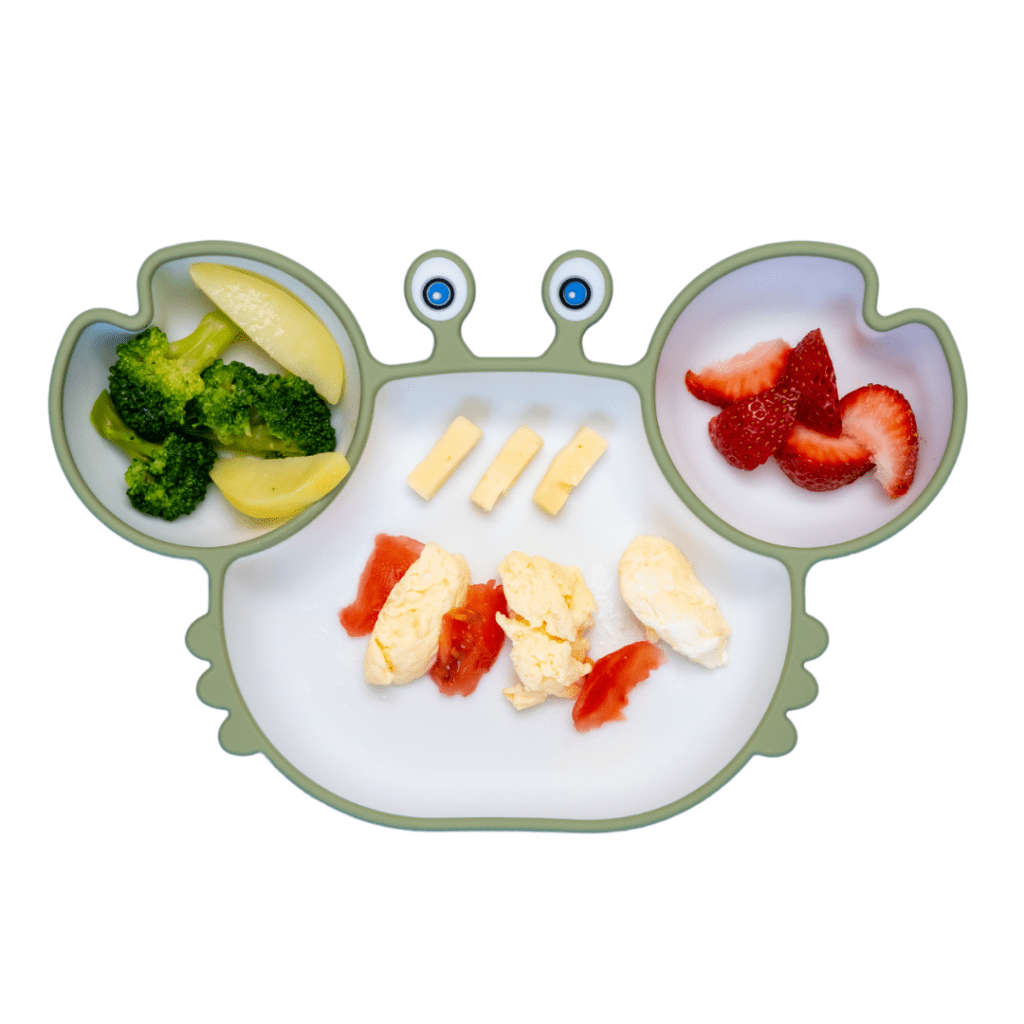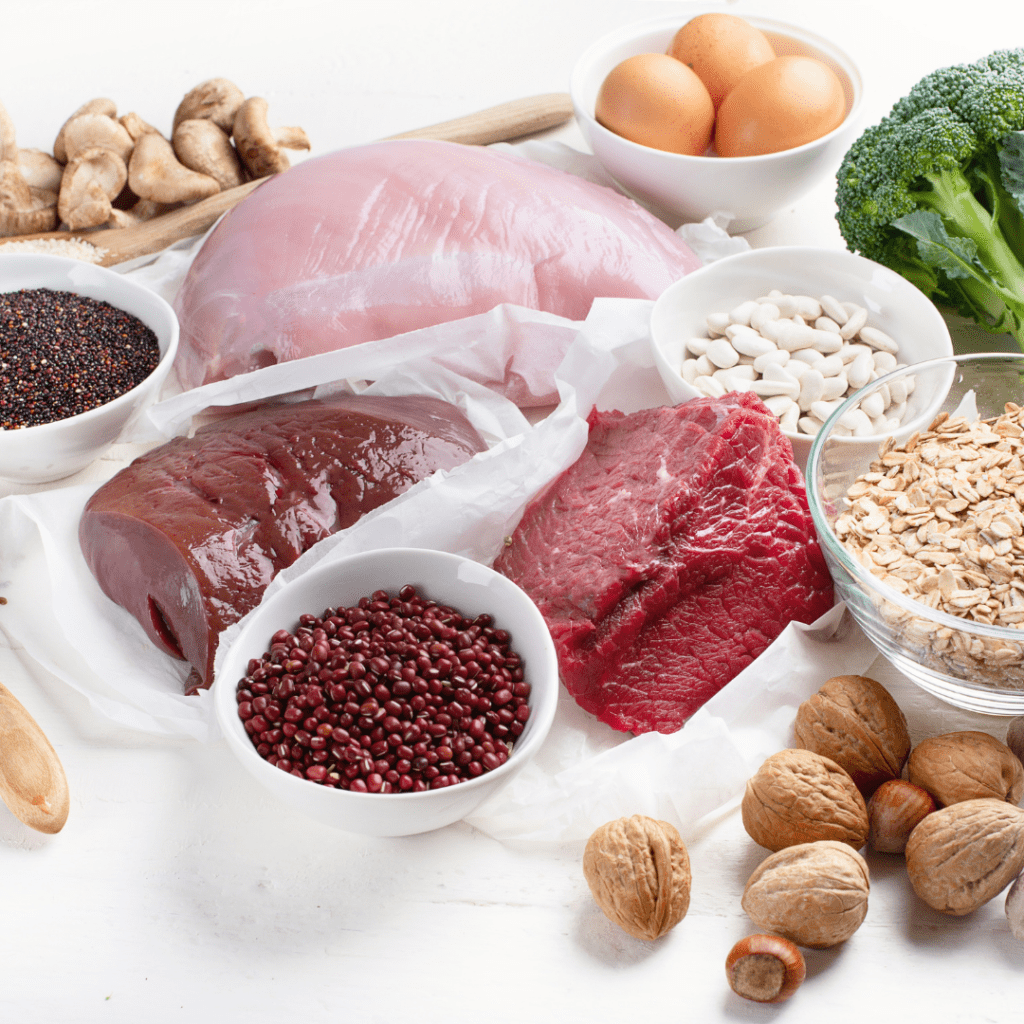It’s officially fall, so you know what that means – it’s time for the annual visit to the pumpkin patch, apple picking, and hay rides! Farmer’s markets are filled with lots of freshly harvested produce, including a host of fall fruits and veggies that can offer a nutritious and flavorful boost to your baby’s diet!
In this blog, we’ll explore the benefits of buying produce when it’s in season, our top 10 favorite fall foods for babies, and how to serve them safely! And that’s not all – we’ve also got a mouthwatering pumpkin pie pancake recipe that isn’t just a perfect breakfast for baby, the entire family is in for a delightful and nutritious fall-inspired breakfast!
Table of Contents
If you want to take the guesswork out of what to pair with seasonal fruits and veggies and ensure your baby is getting nutritionally balanced and nutrient-dense meals, check out our 60 Day Baby Led Feeding Meal Plan – you’ll get access to over 80 recipes that are perfect for starting solids, and that the entire family can enjoy.
This isn’t just a regular meal plan with a list of recipes, you’ll actually be able to follow along with the plan to strategically introduce allergens, advance your baby in textures, and ensure all nutrient needs are being met.

Why shop for in-season fruits and veggies for babies?

There are lots of seasonal fruits and veggies to take advantage of from the months of September to November. We’re big fans of incorporating in-season produce in your little one’s diet, and here’s why (1):
- Enhanced flavor: Fruits and vegetables that ripen on the stem develop a superior taste compared to produce that has been picked early and shipped. This means your little one will be able to experience the full flavor profile of these in-season fruits and veggies – enjoying them just as nature intended!
- Nutrient-rich: The nutritional value of produce starts to diminish shortly after it’s picked. By opting for recently harvested and locally grown produce, your little one will be getting more essential vitamins and minerals, maximizing the health benefits.
- Budget-friendly: While fresh fruits and vegetables, especially organic ones, can be pricey, they’re most affordable when in season. Explore local farmer’s markets or roadside markets that sell in-season produce as they often have much lower prices than your regular supermarket!
- Reduced environmental impact: Most of the produce we eat goes on a long journey to reach us. Buying pumpkins beside the field where they were grown means they didn’t need to be shipped halfway across the country, significantly reducing the environmental impact. Opting for produce grown locally reduces our carbon footprint and supports sustainability.
In-season fall produce
We all know it’s pumpkin season, but here is a complete round-up of in-season fall produce you can choose from! Rotating through these foods from September to November will ensure your little one gets lots of variety in their diet and tons of beneficial nutrients they need for optimal growth and development.
Fruits
- Apples
- Cranberries
- Figs
- Pears
- Pineapples
- Pomegranates
- Pumpkin
Vegetables
- Beets
- Broccoli
- Brussels Sprouts
- Cabbage
- Cauliflower
- Celery
- Eggplant
- Green beans
- Kale
- Parsnips
- Peppers
- Potatoes
- Rutabaga
- Spinach
- Squash: spaghetti, butternut, acorn, buttercup, winter
- Sweet potatoes
- Swiss chard
- Turnips
- Zucchini
The best fall fruits and vegetables for babies, plus how to serve them
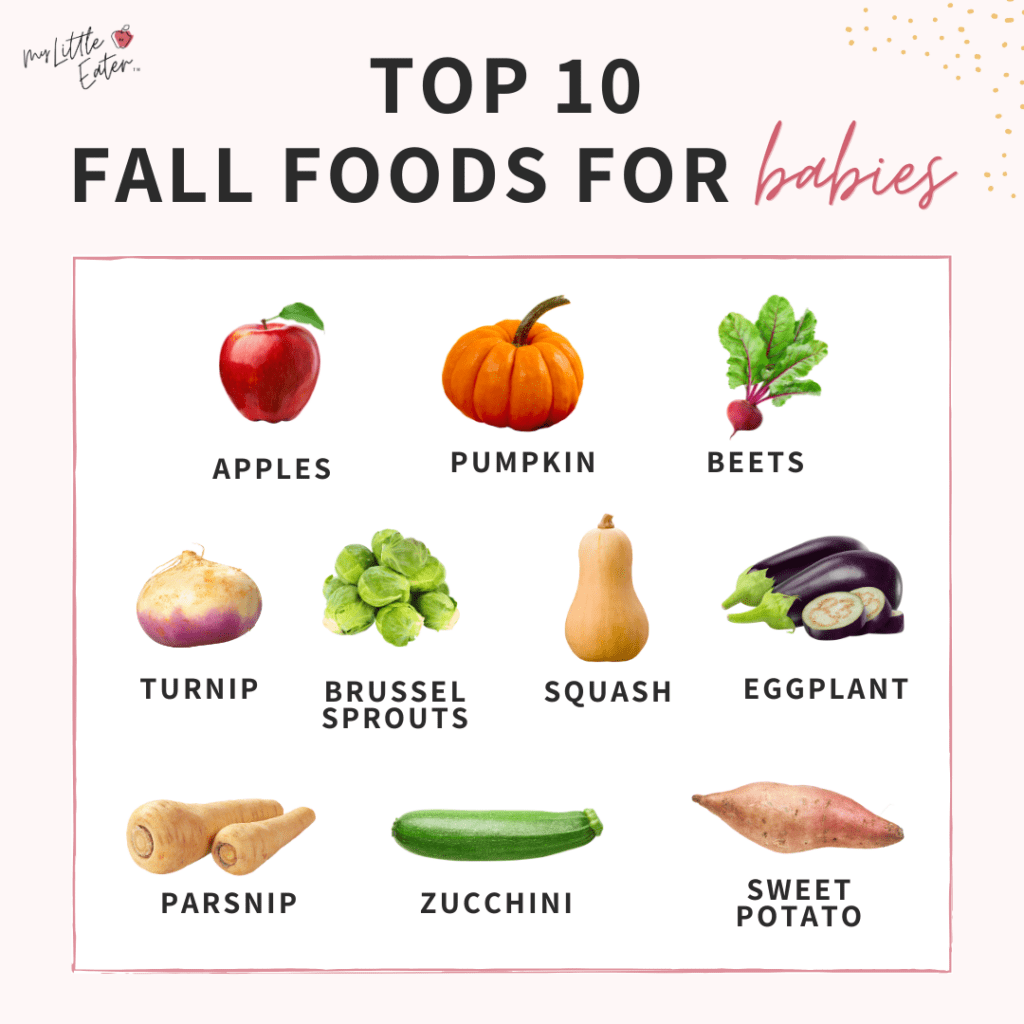
Given that some of these fall veggies are bitter-tasting, have a strong flavor (think beets), are smelly (like Brussels sprouts), or are green vegetables (hello, zucchini), they tend to be in the category of foods kids typically refuse. That’s precisely why we’ve included them in our top 10 list! Our goal is to introduce them to baby as early as possible, and often, as a strategy for exposure and for increasing the likelihood that they eat them in the future.
Beyond their taste and appearance, these fruits and veggies add an excellent source of fiber, which will help support baby’s digestive system and gut health. Additionally, they offer many other nutrients and vitamins, like vitamin C, which will help boost iron absorption. Having these fruits and veggies appear regularly on your baby’s plate and rotating through in-season produce will create a familiarity that can keep picky eating at bay in the future.
Now, the most important part – all of the top 10 fall foods for babies that made the list can be served safely with just some simple modifications! Whether that be cooked until soft and mashed, cut into finger shapes for ease of eating using their palmar grasp, or chopped into bite-sized pieces once they’ve mastered their pincer grasp, we’ve got you covered!
Let’s take a closer look at these top 10 foods, explore their nutritional benefits, and guide you on how to serve them safely to your baby!
Apples

Ranking among the top three fruits produced in the world, apples are certainly a popular food choice so they’re first on our list! There are over 2500 varieties of this sweet and crunchy fruit and the nutrient profile varies depending on the type, but they all provide numerous health benefits!
NUTRITIONAL BENEFITS
Apples are rich in the following nutrients (2):
- Dietary fiber: Apples contain both soluble and insoluble fiber, both beneficial for keeping our gastrointestinal tract healthy. Apples also contain pectin, a type of soluble fiber useful for preventing constipation.
- Antioxidants: Apples are abundant in polyphenols, which are naturally occurring plant chemicals. Polyphenols are a diverse group of antioxidants that play numerous roles within our body including keeping our cells healthy and protecting us against many chronic diseases.
Apples also contain other beneficial nutrients in small amounts including vitamins B6 and E, potassium, calcium, magnesium, zinc, copper, iron, and manganese (2).
HOW TO SERVE APPLES SAFELY

Blended cooked apples, applesauce, or cooked mashed apples (small lumps are ok):
- Preloaded spoon: Offer to baby on a preloaded spoon for them to self-feed with, spoon-feed it to them, or let them get messy by digging in with their hands.
Cooked halved apples or wedges (feel free to add some butter and cinnamon):
- Palmar grasp: Ensure the apple is cooked until it’s tender and soft enough for baby to squish between their gums. Cook apples by boiling in a pot for about 15 minutes (depending on the size of the apple) or until you can easily pierce through it with a fork.
- Pincer grasp: Once baby has mastered their pincer grasp, you can serve cooked apples in bite-sized pieces.
Raw apples, thinly grated or thin slices:
- Preloaded spoon: Mix thinly grated apples into a puree to bind the pieces together and add more moisture. You can use Greek yogurt, hummus, or avocado. Serve to baby on a preloaded spoon for baby to self-feed with.
- Palmar grasp: Grate the raw apple into very thin slices using a mandolin or the slicing side of a cheese grater. The pieces should be bendable and somewhat see-through.
- Pincer grasp: You can serve thinly grated raw, ripe apples on their own for baby to eat using their pincer grasp. Ensure the apple is ripe enough that it can be squished (but doesn’t instantly dissolve) between your thumb and forefinger.
BEST FOOD & SPICE PAIRINGS
Pumpkin
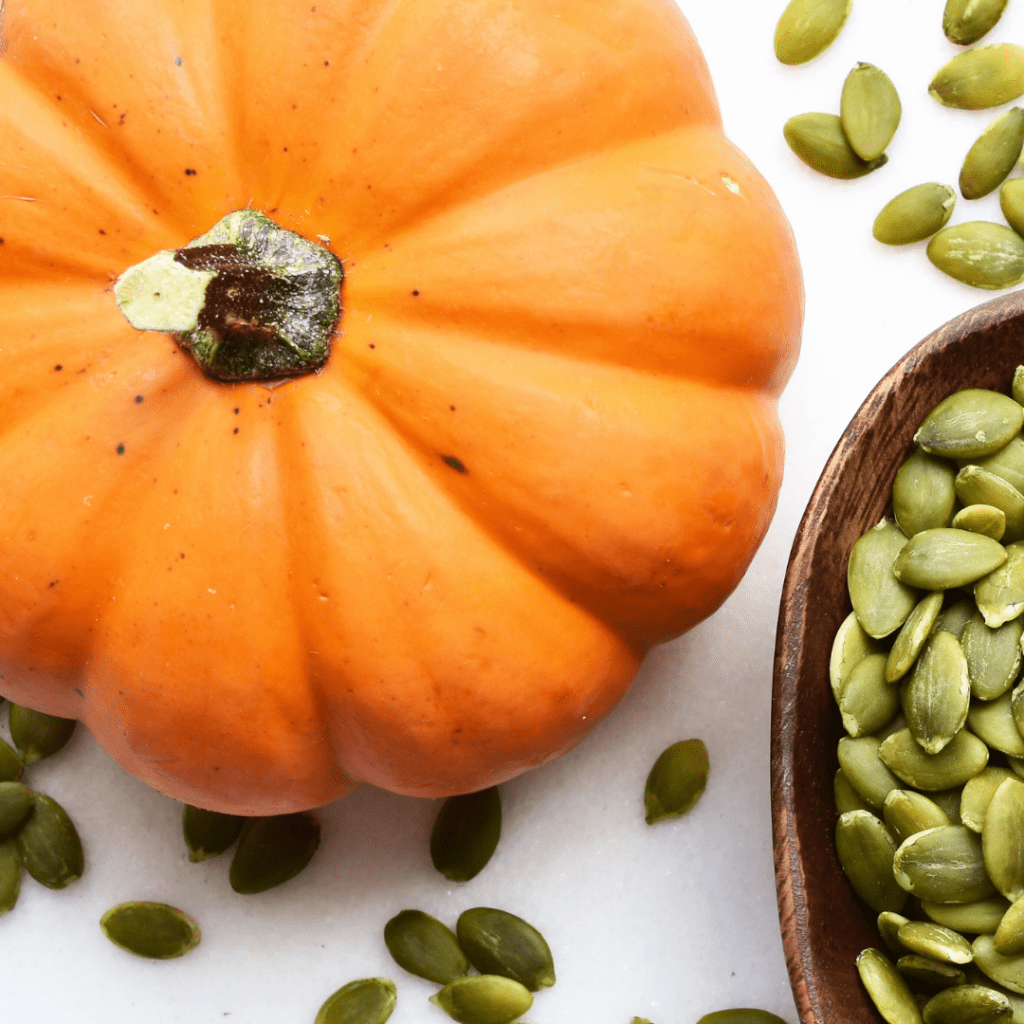
Although most of us are used to seeing large, round, orange pumpkins, pumpkins can vary in shape, size, and color! However, bright orange pumpkins tend to be nutritionally superior compared to other varieties (3).
NUTRITIONAL BENEFITS
Pumpkin is rich in the following nutrients (3):
- Vitamin A: Pumpkins contain high amounts of carotenoids, a term used to describe a type of plant compound. Our body converts some of these carotenoids into vitamin A, which is beneficial for forming and maintaining healthy teeth, tissues, mucus membranes, and skin, plus it promotes good eyesight. Pumpkin also contains antioxidants that help protect cells from damage.
- Dietary fiber: Pumpkins are high in fiber, which is beneficial for gut health and digestion.
Pumpkin also provides other essential nutrients in smaller quantities including vitamins E and C, carbohydrates, potassium, phosphorus, iron, and manganese (3).
HOW TO SERVE PUMPKIN SAFELY
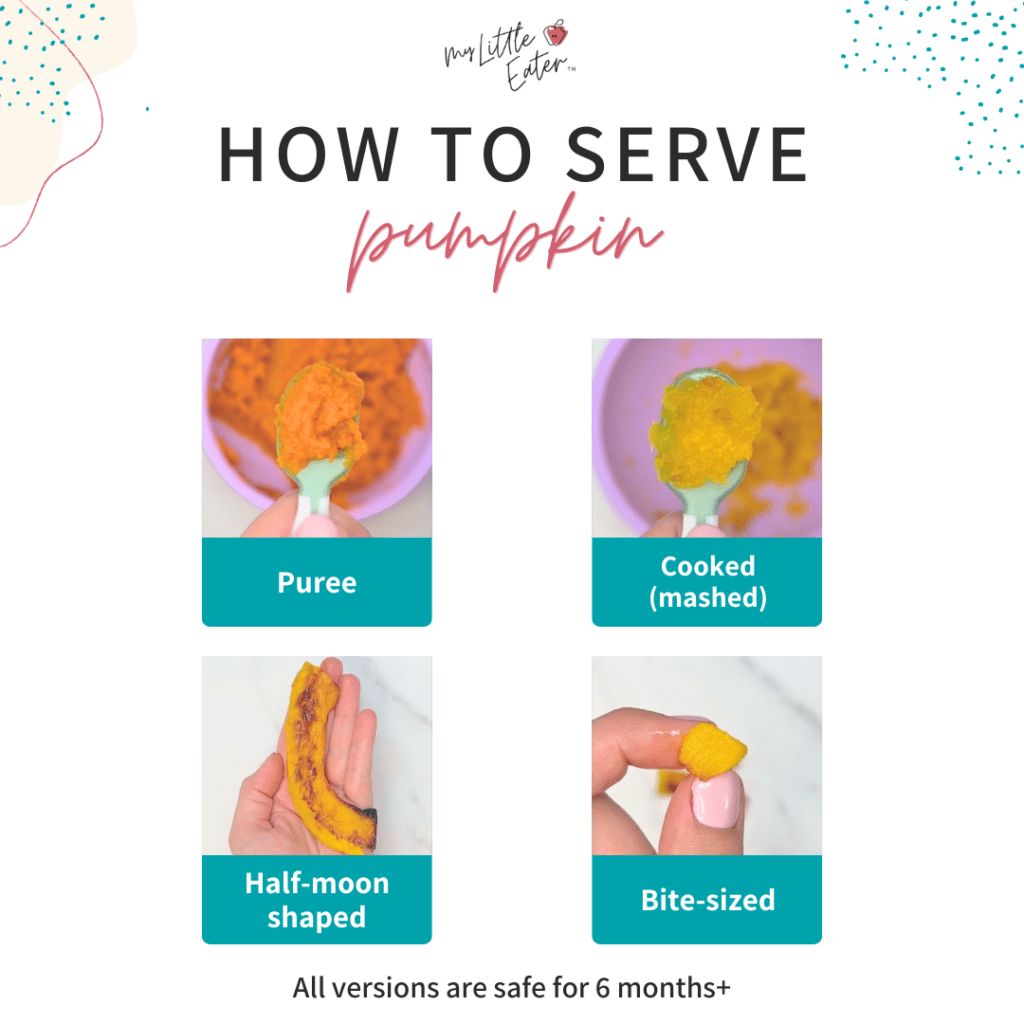
Mashed cooked pumpkin or pumpkin puree:
- Preloaded spoon: Cook pumpkin by roasting small sections in the oven (400°F for 35 to 45 minutes) until it becomes soft and can be easily mashed. Mash with a fork and serve to baby on a preloaded spoon for them to self-feed with, spoon-feed it to them, or let them get messy by digging in with their hands!
Roasted half-moons or bite-sized:
- Palmar grasp: Serve cooked pumpkin in a half-moon shape with the skin removed for baby to eat using their palmar grasp.
- Pincer grasp: Cut cooked pumpkin into small bite-sized pieces (½ to 1 inch in size) with the skin removed for baby to eat using their pincer grasp.
BEST FOOD & SPICE PAIRINGS
- Foods: Cream cheese, tomato, corn, or quinoa.
- Herbs and spices: Cinnamon, curry, sage, or rosemary.
Beets
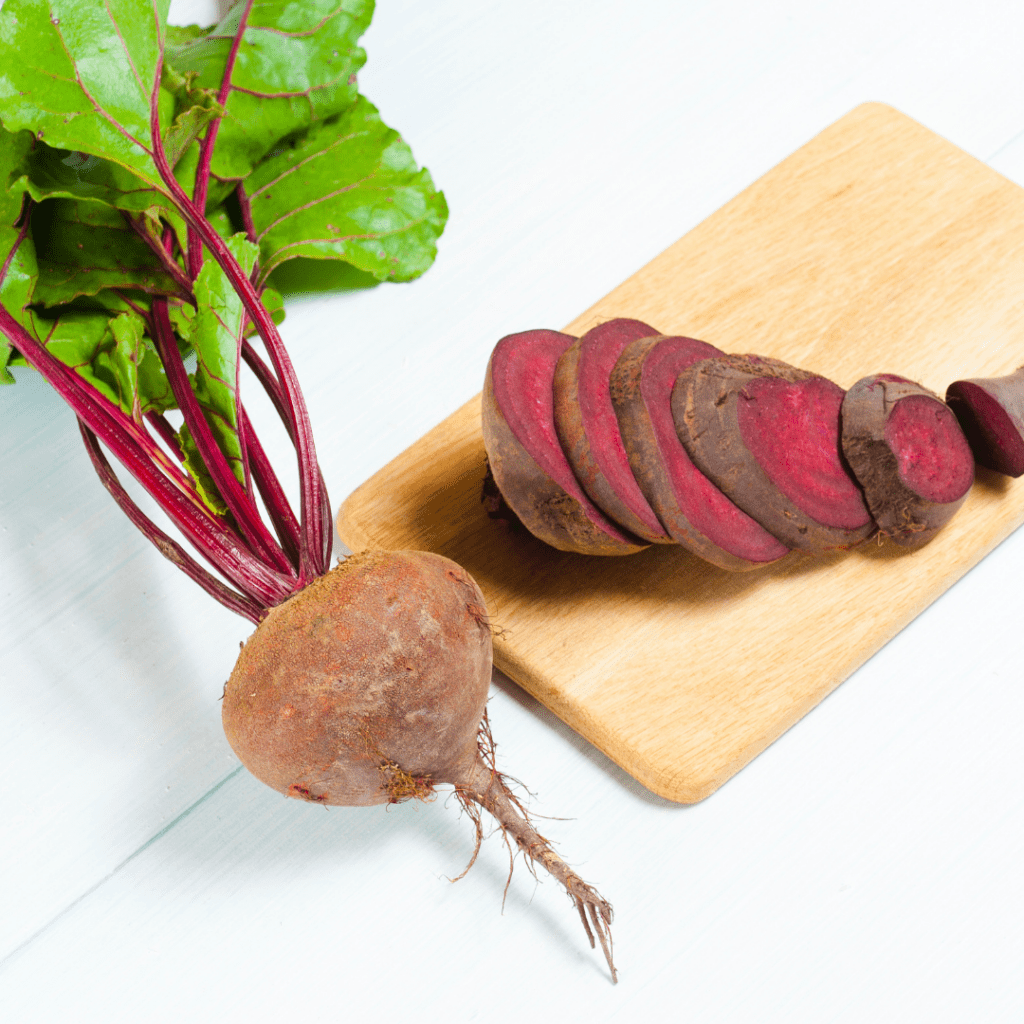
Beetroot comes in different varieties, including yellow, white, and the most commonly consumed, dark red. They all have their own unique combination of nutrients, with dark red beets providing the highest amount compared to the other varieties (4)!
NUTRITIONAL BENEFITS
Beets are rich in the following nutrients (4):
- Antioxidants: Beets are packed full of beneficial nutrients and contain a considerable amount of polyphenols and phenolic compounds, which are both beneficial chemicals found in plants that act as antioxidants in our bodies.
- Dietary fiber: Beets are beneficial for gut health and digestion due to their high fiber content.
- Folate: Required for cell growth and genetic functions.
Beets contain small amounts of other essential nutrients for baby including vitamin C, manganese, potassium, and iron (4).
HOW TO SERVE BEETS SAFELY
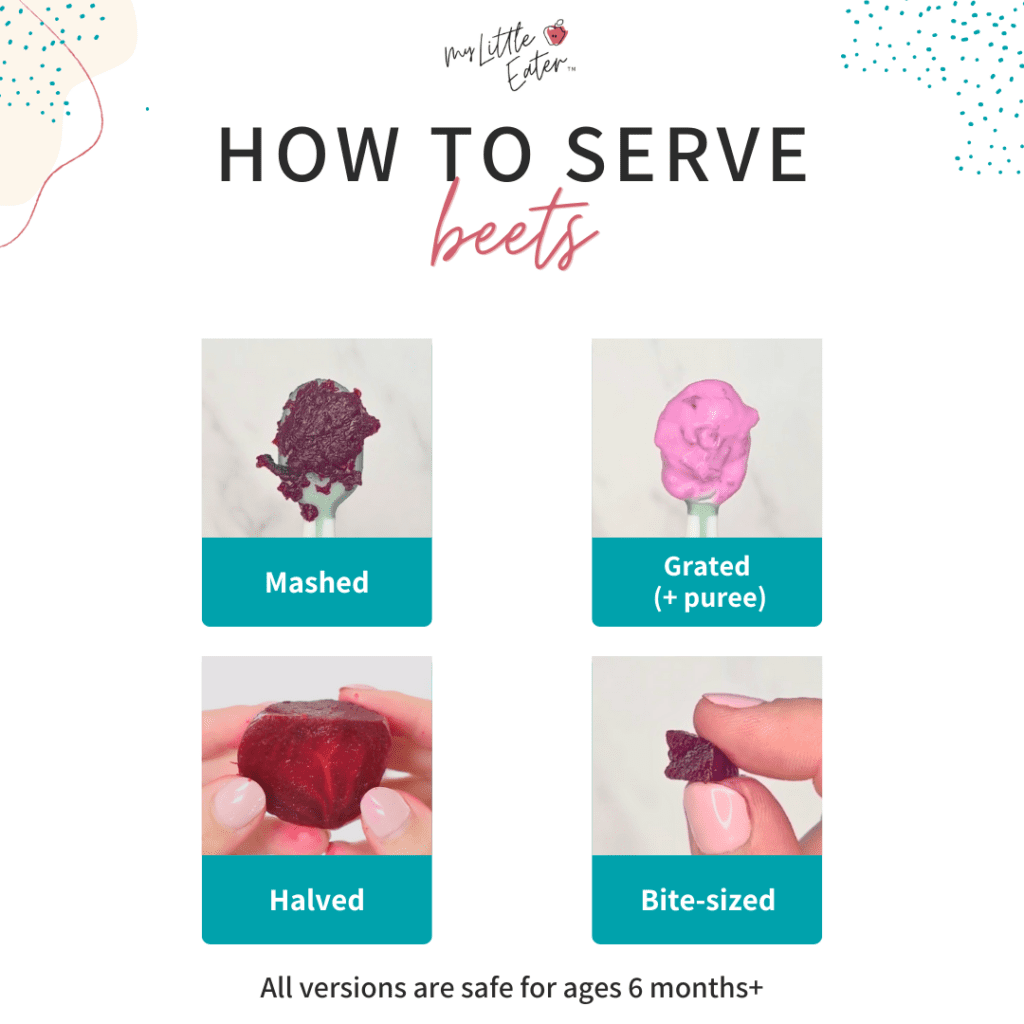
Mashed cooked beets
- Preloaded spoon: Cook beets by boiling them in water until they become soft and can be easily mashed (35 to 45 minutes depending on the size of the beet). Mash with a fork and serve to baby on a preloaded spoon for them to self-feed with, spoon-feed it to them, or let them get messy by digging in with their hands!
Cooked beets, thinly grated
- Preloaded spoon: Mix thinly grated beets (made using a cheese grater) into a puree to bind the pieces together and add more moisture. You can use Greek yogurt, hummus, or mashed potatoes. Serve to baby on a preloaded spoon for baby to self-feed with.
Cooked halved beets
- Palmar grasp: Ensure the beets are cooked until they’re tender and soft enough for baby to squish between their gums. Remove the skin and cut the beet in half for baby to eat using their palmar grasp.
- Pincer grasp: Once baby has mastered their pincer grasp, you can serve cooked beets in bite-sized pieces (½ to 1 inch in size).
BEST FOOD & SPICE PAIRINGS
- Foods: Goat cheese, yogurt, avocado, or quinoa.
- Herbs and spices: Cumin, paprika, thyme, or tarragon.
Brussels Sprouts
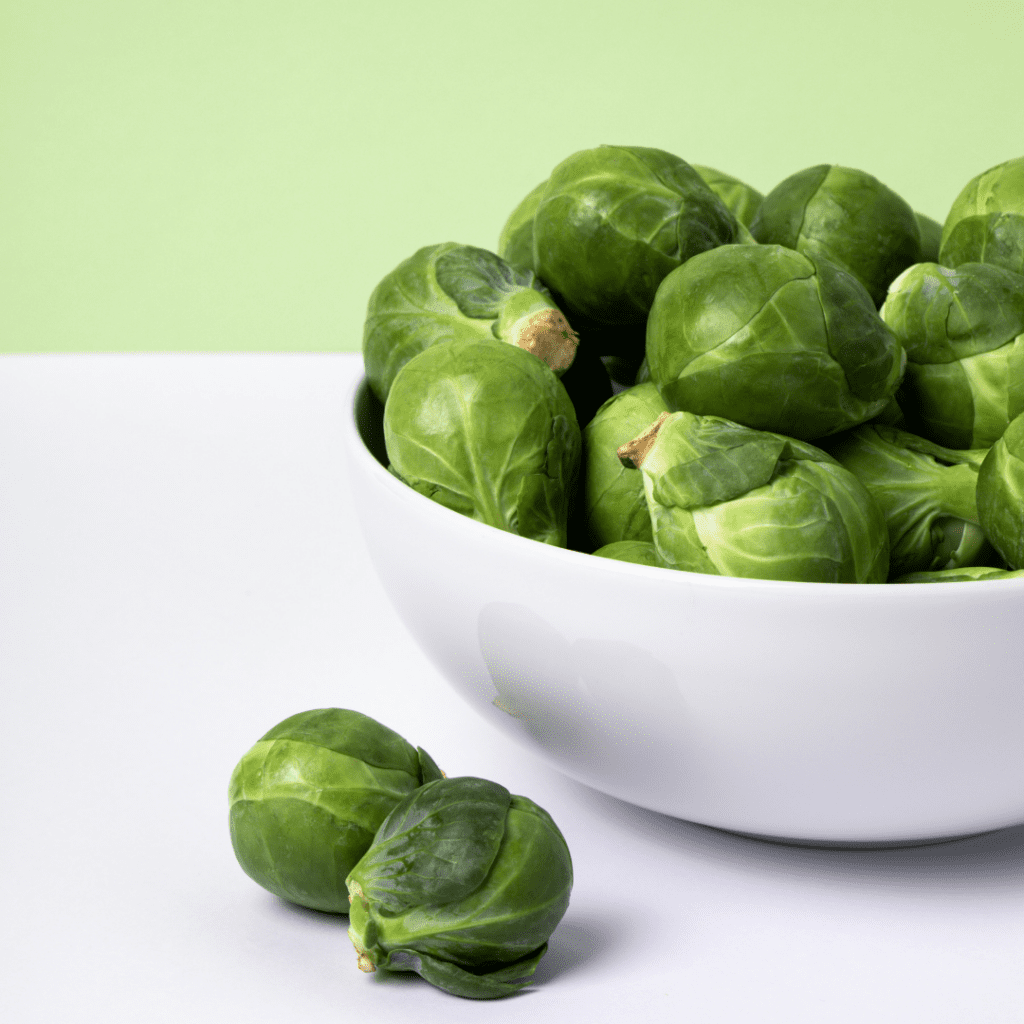
Brussels sprouts come from the cruciferous family of plants, closely related to kale, broccoli, and cauliflower. Brussels sprouts naturally contain sulfur, which is responsible for their distinctive smell and bitter taste.
NUTRITIONAL BENEFITS
Brussels sprouts are rich in the following nutrients (5):
- Antioxidants: These are beneficial for maintaining healthy cells, and are needed for optimal brain and organ function.
- Vitamin C: Beneficial for maintaining a healthy immune system and skin health.
- Dietary fiber: Brussels sprouts are high in fiber which is beneficial for digestion and can help prevent constipation when consumed on a regular basis.
Brussels sprouts also contain smaller amounts of other essential nutrients for babies including B vitamins, vitamin K, potassium, folate, and vitamin A (5).
HOW TO SERVE BRUSSELS SPROUTS SAFELY
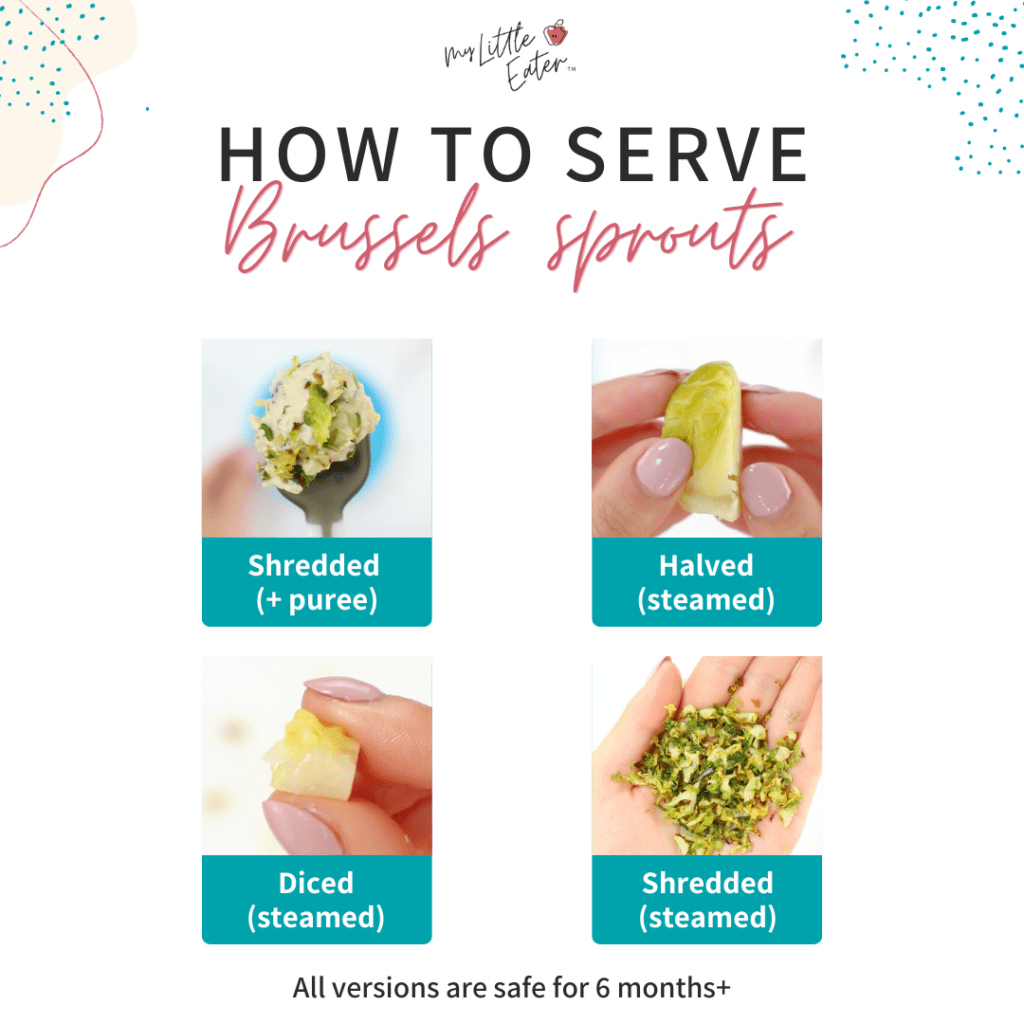
Steamed shredded Brussels sprouts
- Preloaded spoon: Mix finely chopped or shredded Brussels sprouts (steamed for approximately 8 minutes or until soft enough to easily pierce with a fork) into a puree to bind the pieces together and add more moisture. This will make it easier for baby to chew and swallow. Try mixing Greek yogurt, hummus, or mashed potatoes with the Brussels sprouts. Serve to baby on a preloaded spoon for baby to self-feed with.
Steamed halved, bite-sized, or shredded Brussels sprouts
- Palmar grasp: Serve halved or quartered, steamed Brussels sprouts for baby to eat using their palmar grasp.
- Pincer grasp: Cut Brussels sprouts into small bite-sized pieces (½ to 1 inch in size) or use a knife or cheese grater to shred steamed Brussels sprouts for baby to eat using their pincer grasp.
Note: Roasted Brussels sprouts are a more advanced texture best left for 12 months+.
BEST FOOD & SPICE PAIRINGS
- Foods: Beef, fish, carrots, or potatoes.
- Herbs and spices: Thyme, basil, dill, or chives.
Eggplant
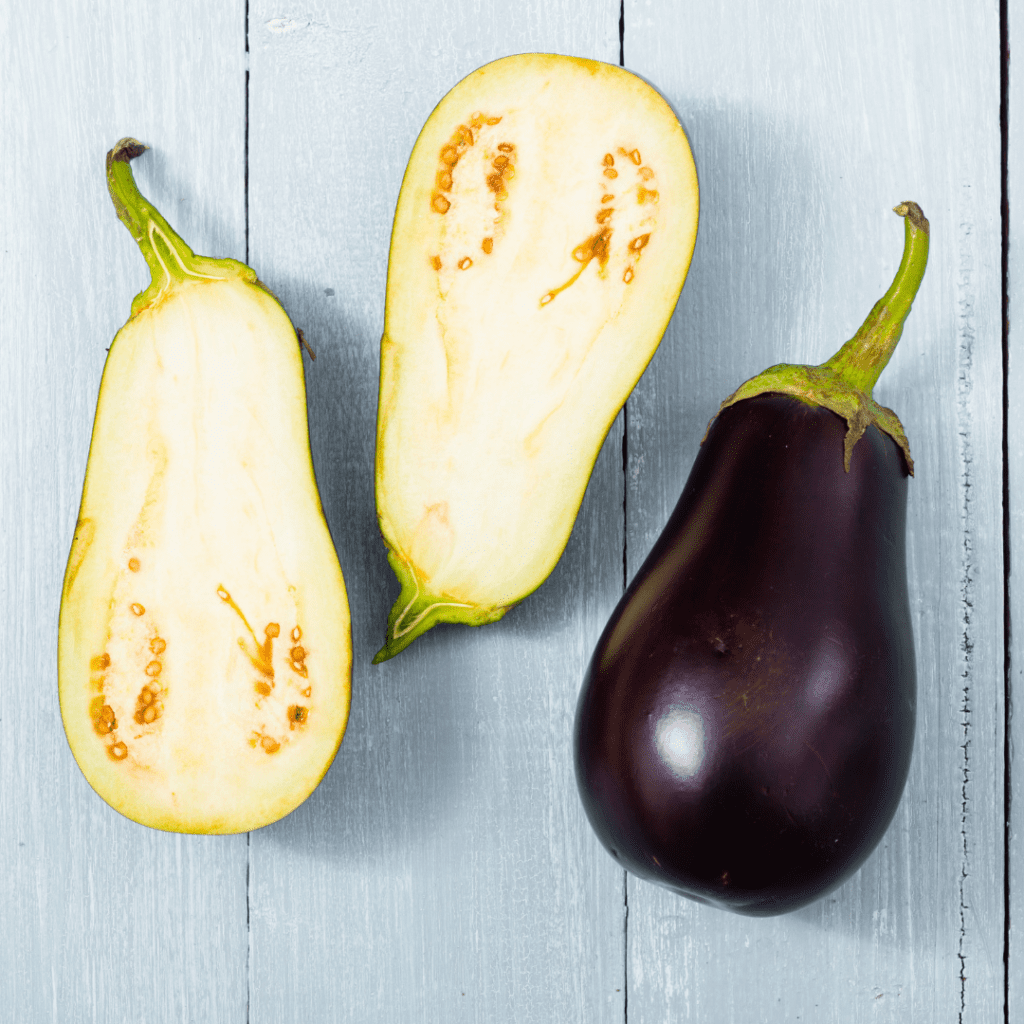
Eggplants are cultivated and consumed in almost all parts of the world. They’re ranked among the top 10 vegetables for having the highest content of antioxidant properties (6)! Although we’re used to seeing purpled-colored varieties, eggplants come in a wide variety of sizes, colors, and shapes.
NUTRITIONAL BENEFITS
Eggplant is rich in the following nutrients (6):
- Dietary fiber: Eggplant is an excellent source of fiber for baby, which is beneficial for gut health and digestion. It can help prevent constipation when consumed on a more regular basis!
- Phenols: Eggplant is also rich in phenols, which are plant compounds that have antioxidant effects within the body. Antioxidants are beneficial for maintaining healthy cells, and optimal brain and organ function.
Eggplant also provides some other essential vitamins and minerals in smaller amounts including vitamin B6, manganese, folate, and potassium (6).
HOW TO SERVE EGGPLANT SAFELY
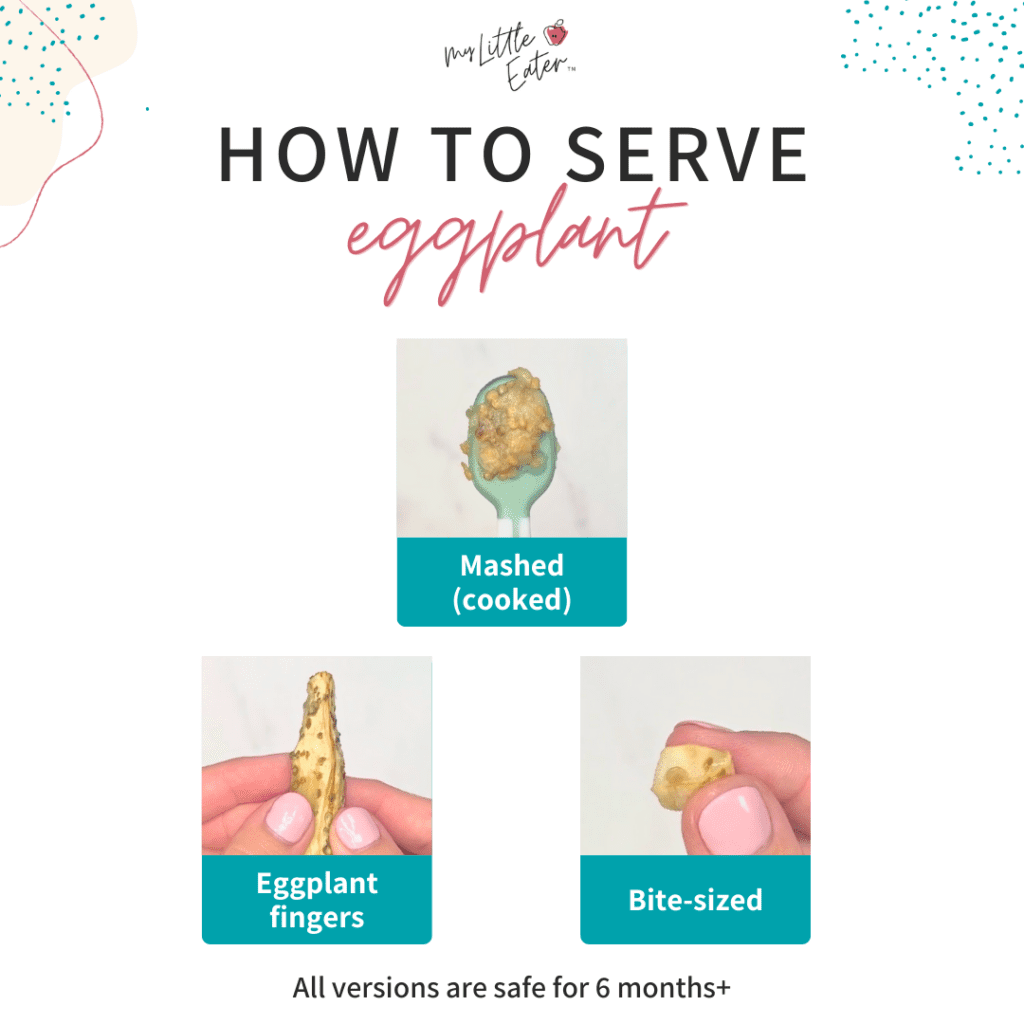
Mashed cooked eggplant
- Preloaded spoon: Cook eggplant by roasting in the oven until it’s soft and can be easily mashed (400°F for approximately 30 minutes). Mash with a fork and serve to baby on a preloaded spoon for them to self-feed with, spoon-feed it to them, or let them get messy by self-feeding with their hands.
Roasted spears or bite-sized
- Palmar grasp: Serve cooked eggplant as a finger food in a long spear (about the length of an adult finger) for baby to eat using their palmar grasp.
- Pincer grasp: Once baby has developed their pincer grasp, you can cut cooked eggplant into small bite-sized pieces (½ to 1 inch in size).
BEST FOOD & SPICE PAIRINGS
- Foods: Goat cheese, yogurt, tomatoes, or lamb.
- Herbs and spices: Lemon, garlic, chili, or basil.
Parsnips
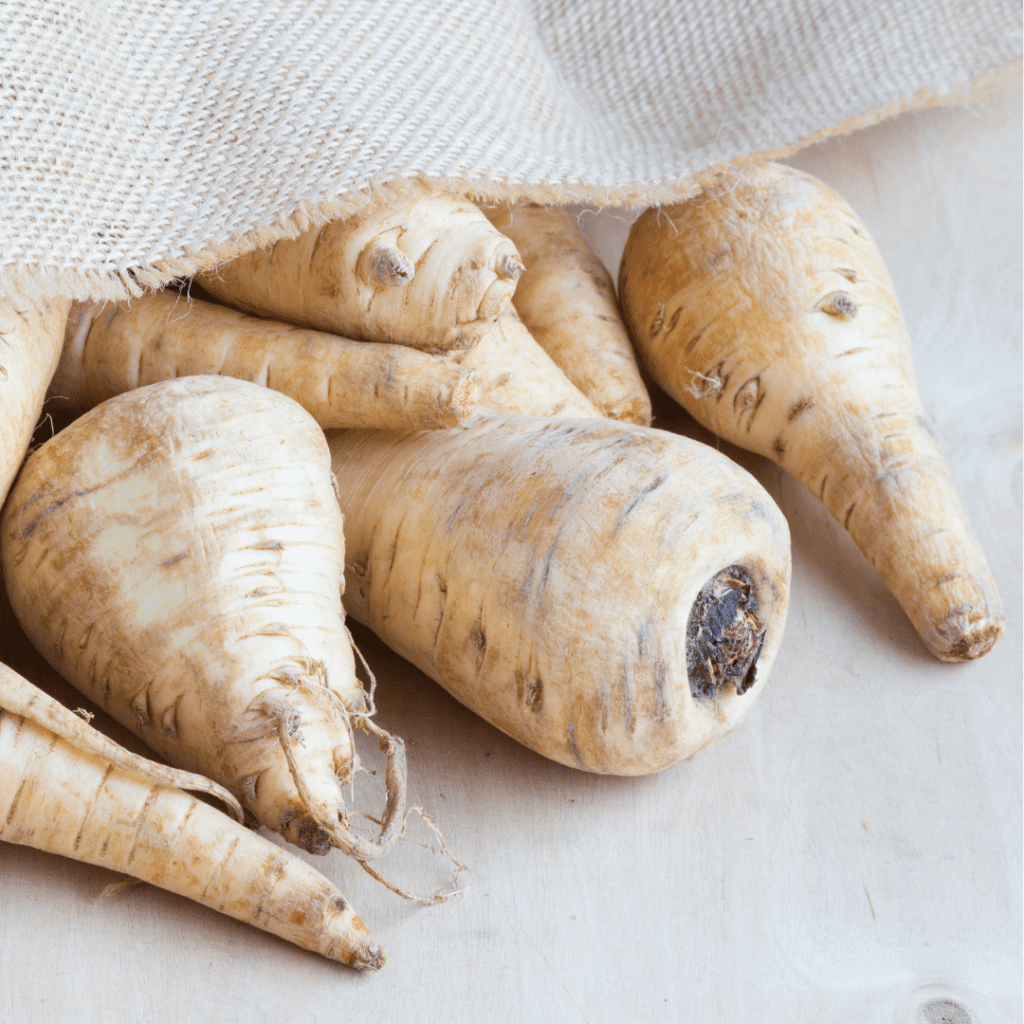
Parsnips have a sweet and nutty flavor with a characteristic aroma. They’re a root vegetable related to the carrot, except for its light yellow color (7). Unlike carrots, parsnips do not contain beta-carotene, but they have a stronger flavor and are richer in vitamins and minerals than most carrots (7).
NUTRITIONAL BENEFITS
Parsnips are rich in the following nutrients (7):
- Dietary fiber: Parsnips are a good source of fiber, which is beneficial for gut health and digestion.
- Vitamin C: Beneficial for maintaining a healthy immune system and skin health.
- Potassium: This is beneficial for proper muscle function and regulation of blood pressure.
Parsnips also contain other essential nutrients in smaller quantities including vitamin K and folate (7).
HOW TO SERVE PARSNIPS SAFELY
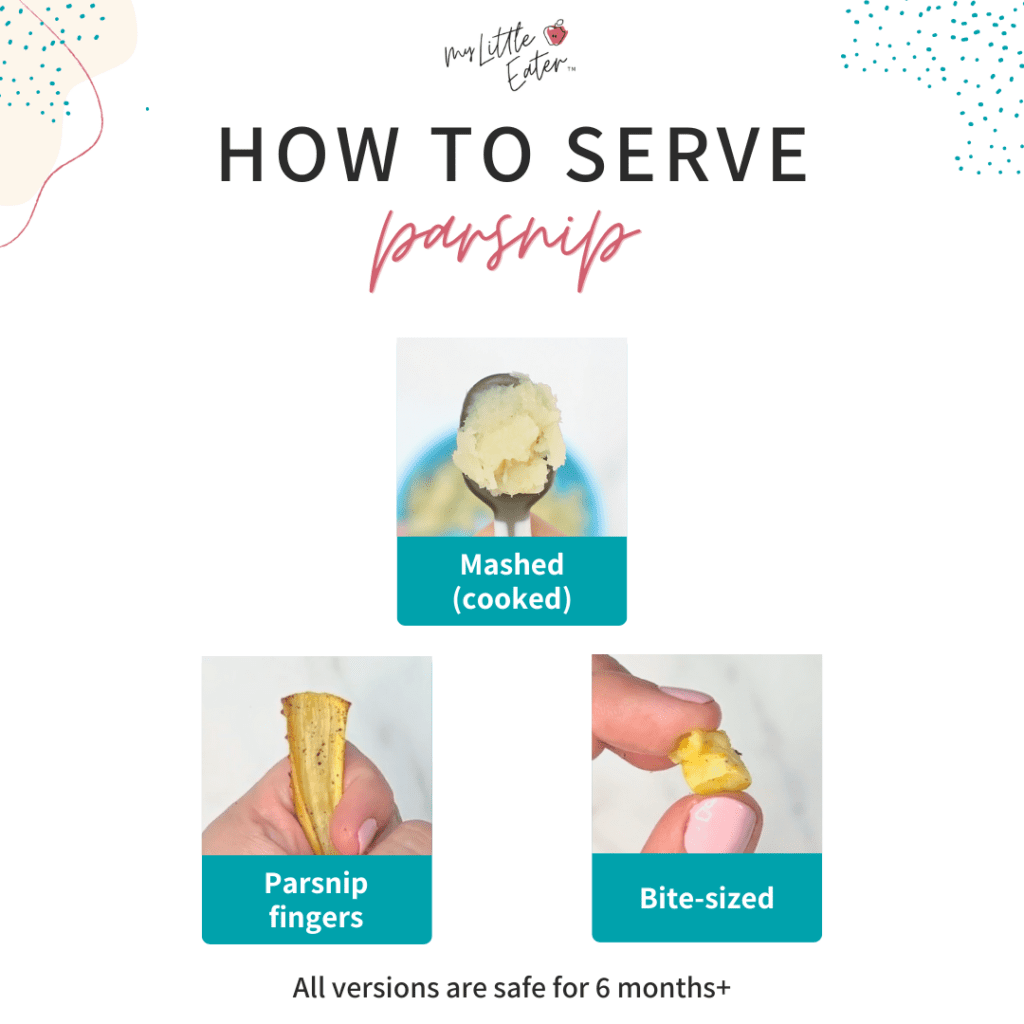
Mashed cooked parsnip
- Preloaded spoon: Cook parsnips by roasting them in the oven until they’re soft and can be easily mashed (425°F for 25 to 30 minutes). Mash with a fork and serve to baby on a preloaded spoon for them to self-feed with, spoon-feed it to them, or let them get messy by self-feeding with their hands.
Roasted parsnip fingers or bite-sized pieces
- Palmar grasp: Serve roasted parsnips in long finger shapes (about the length of an adult finger) for baby to eat using their palmar grasp.
- Pincer grasp: Once baby has developed their pincer grasp, you can cut cooked parsnips into small bite-sized pieces (½ to 1 inch in size).
BEST FOOD & SPICE PAIRINGS
- Foods: Goat cheese, pork, apples, or squash.
- Herbs and spices: Nutmeg, sage, garlic, thyme, or paprika.
Squash
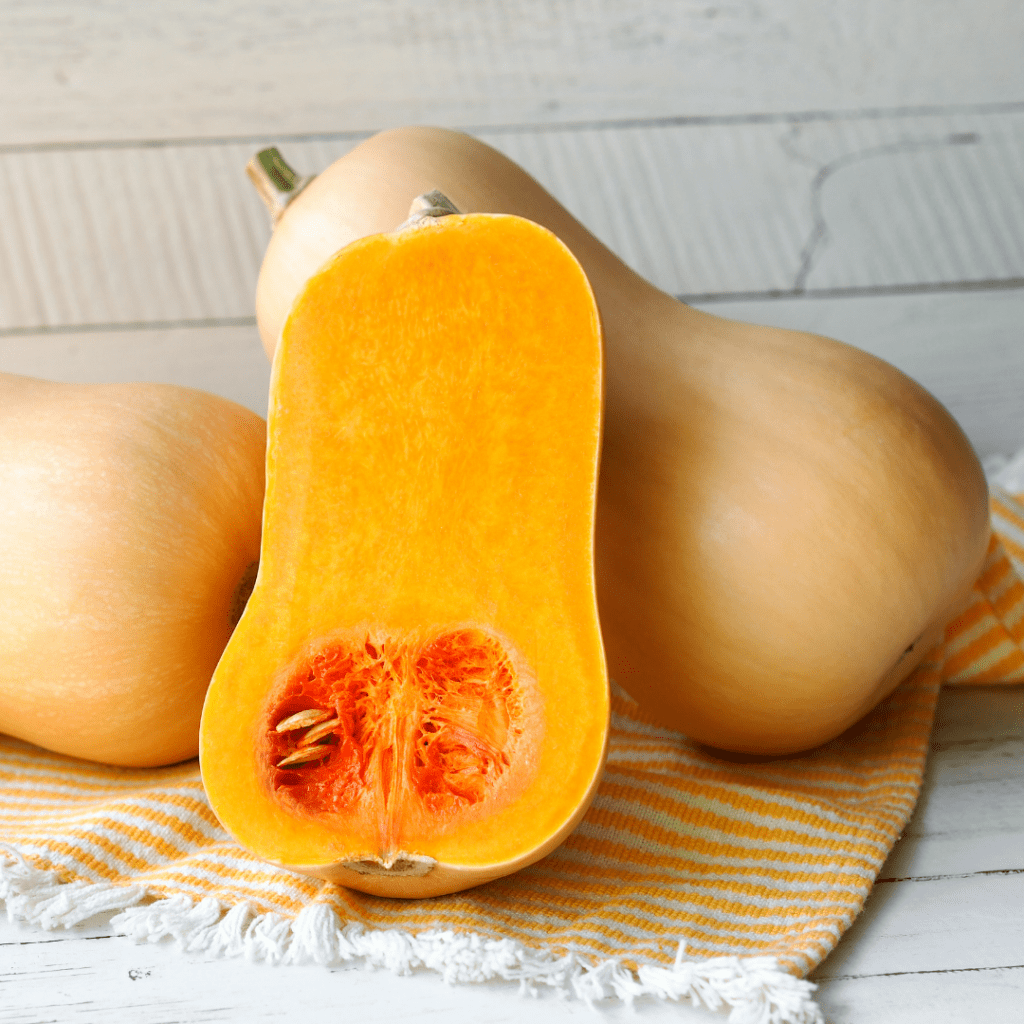
Squashes can come in two types: winter and summer, and while they do share some similarities and benefits, there are a few major differences like their nutritional values and the time of year they’re harvested (8). Common varieties of squash include butternut, spaghetti, buttercup, and acorn squash, all of which are in season during the fall. We will focus on butternut squash, as it’s the most popular type of squash consumed among them all!
NUTRITIONAL BENEFITS
Butternut squash is rich in the following nutrients (9):
- Dietary fiber: Butternut squash is an excellent source of fiber, which is beneficial for gut health and digestion. It can help prevent constipation when consumed on a more regular basis!
- Vitamin C: For maintaining a healthy immune system and skin health (it’s a great food to pair with plant-based iron sources to help with iron absorption).
- Beta-carotene: This is a plant compound that our bodies convert to vitamin A – great for eye and skin health, and functions as an antioxidant.
Butternut squash also offers smaller amounts of other beneficial nutrients including vitamin B6, magnesium, and potassium (9).
HOW TO SERVE SQUASH SAFELY
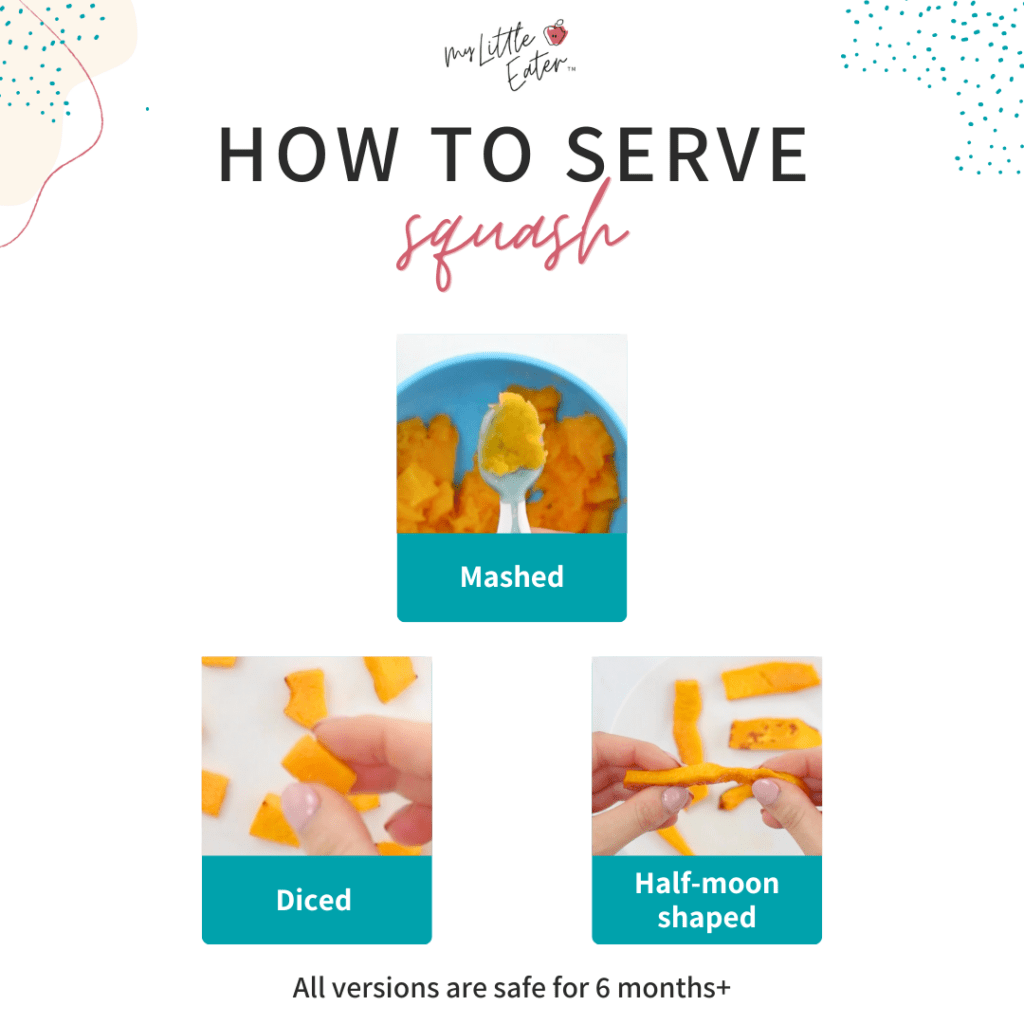
Mashed cooked squash
- Preloaded spoon: Cook squash by roasting it in the oven until it becomes soft and can be easily mashed (400°F for approximately 50 minutes). Mash with a fork and serve to baby on a preloaded spoon for them to self-feed with, spoon-feed it to them, or let them get messy by digging in with their hands!
Roasted half-moons or bite-sized pieces
- Palmar grasp: Serve cooked squash in a half-moon shape with the skin removed for baby to eat using their palmar grasp.
- Pincer grasp: Cut cooked squash into small bite-sized pieces (½ to 1 inch in size) for baby to eat using their pincer grasp.
BEST FOOD & SPICE PAIRINGS
- Foods: Chicken, pork, almonds, or rice.
- Herbs and spices: Rosemary, sage, ginger, or cinnamon.
Sweet potato
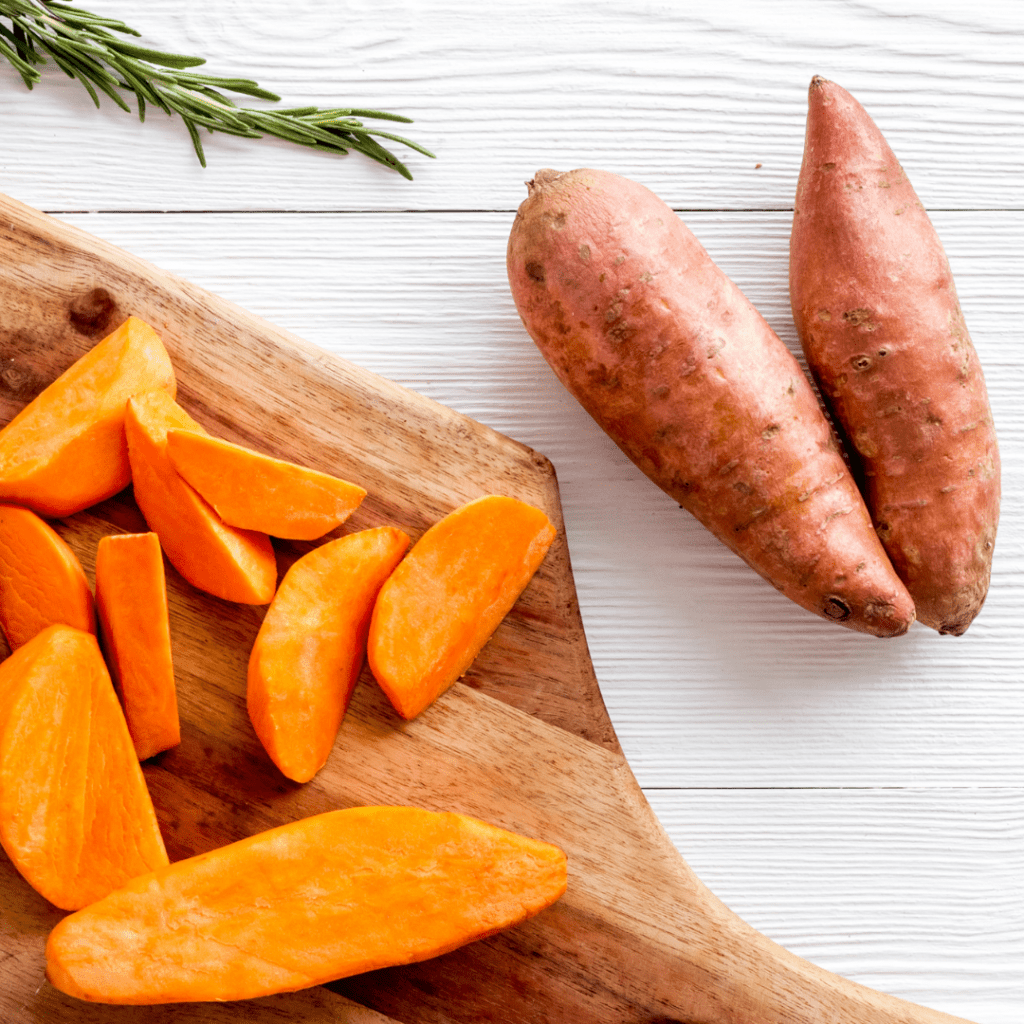
Sweet potatoes are a root vegetable, very commonly served as a first food for babies as they have a thick and creamy texture. The color of sweet potato can range from white, yellow, orange, and red to purple (10). Although the term sweet potato is sometimes used to describe yams and vice versa, they’re actually two very different types of root vegetables!
NUTRITIONAL BENEFITS
Sweet potatoes are rich in the following nutrients (10):
- Beta-carotene: Orange-fleshed sweet potatoes in particular are rich in this (which converts to vitamin A) – great for the eyes and skin, and it functions as an antioxidant.
- Dietary fiber: A source of carbohydrates and energy for your little one. Fiber is also beneficial for your baby’s digestive and gut health.
They’re also considered to be a good source of minerals (magnesium, iron, copper, manganese, calcium, potassium) and vitamins (B6, C, E), which are essential for many different functions within your baby’s growing body (10). The vitamins and minerals found in sweet potatoes can help with brain development, creating and maintaining healthy cells, supporting nerve function, developing strong bones and muscles, and more!
Sweet potatoes, as well as other food crops like rice, absorb trace amounts of arsenic and heavy metals from the soil in which they’re grown (11). This is a result of pollution and contaminants that have accumulated within the soil over hundreds of years (11). This doesn’t mean you shouldn’t offer sweet potatoes to your little one! As long as you’re offering variety and not serving foods containing heavy metals too frequently, there’s no need to worry!
HOW TO SERVE SWEET POTATO SAFELY
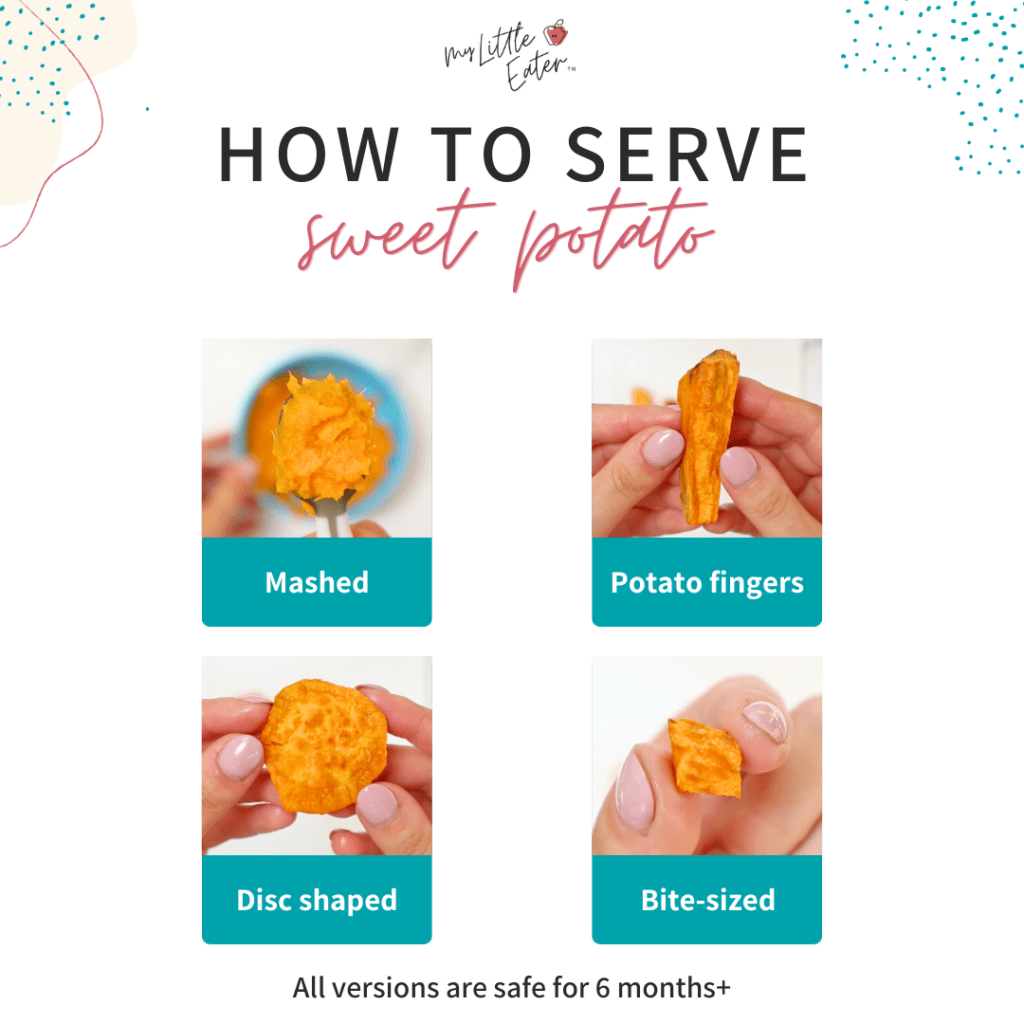
Cooked, mashed sweet potato
- Preloaded spoon: Cook sweet potatoes by roasting them in the oven (400°F for 20-25 minutes) until they’re soft and easily mashed. Mash with a fork and serve to baby on a preloaded spoon for them to self-feed with, spoon-feed it to them, or let them get messy by self-feeding with their hands.
Sweet potato fingers, discs, or bite-sized pieces
- Palmar grasp: Serve cooked sweet potato fingers (about the length of an adult finger) or thin discs (¼ inch to ½ inch thick), for baby to eat using their palmar grasp.
- Pincer grasp: Once baby has developed their pincer grasp, you can cut cooked sweet potato into small bite-sized pieces (½ to 1 inch in size).
BEST FOOD & SPICE PAIRINGS
- Foods: Chicken, chickpeas, cauliflower, or coconut.
- Herbs and spices: Thyme, cinnamon, coriander, or allspice.
Turnip
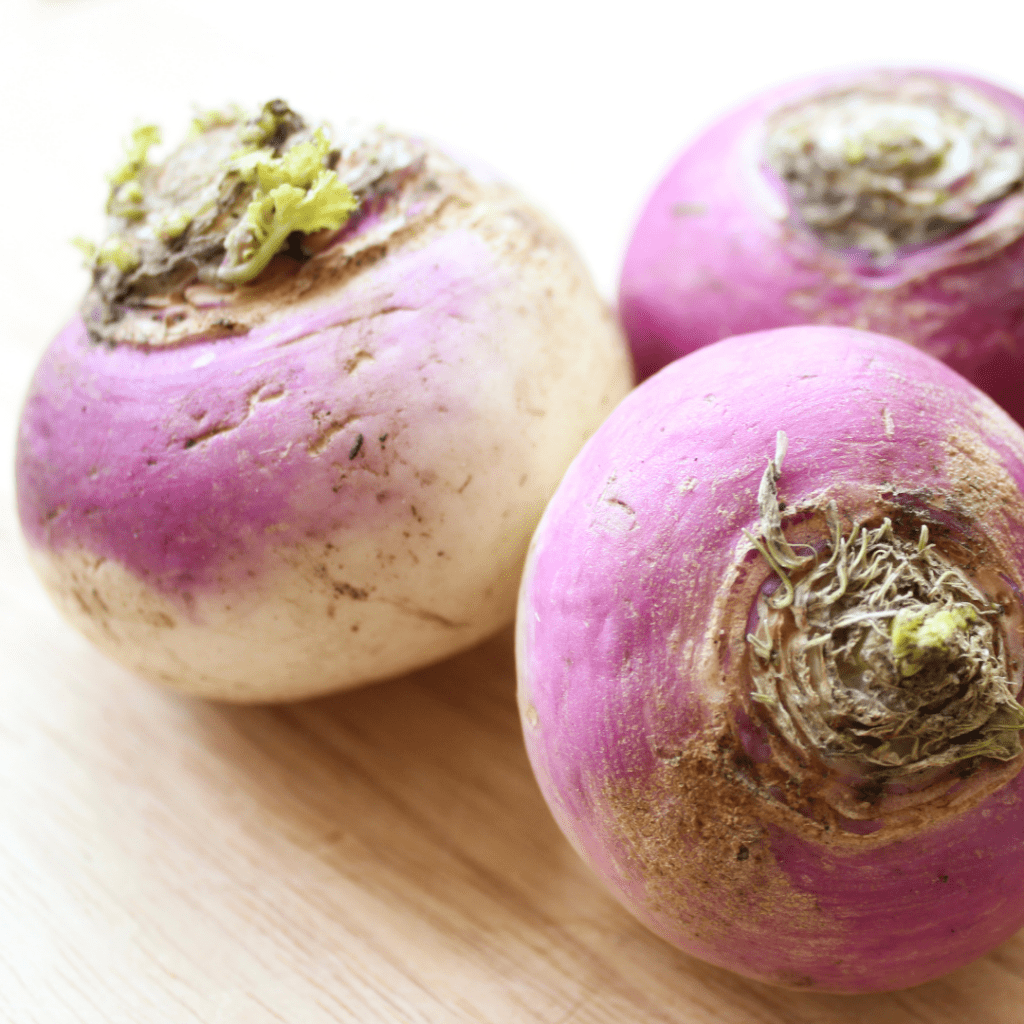
There are various varieties of turnips, all of which provide beneficial nutrients and are commonly used as an ingredient in stews and soups. A bitter taste, particular sulfurous aroma, and pungent flavor are the main characteristics of turnips (12).
NUTRITIONAL BENEFITS
Turnip is rich in the following nutrients (13):
- Antioxidants: Turnip root contains numerous antioxidants that are beneficial for maintaining healthy cells and for optimal brain and organ function.
- Dietary fiber: Beneficial for gut health and digestion.
- Vitamin C: Required for maintaining a healthy immune system and skin health.
Turnip root also offers smaller amounts of other beneficial nutrients including vitamins B and K, magnesium, and potassium (12).
HOW TO SERVE TURNIP SAFELY
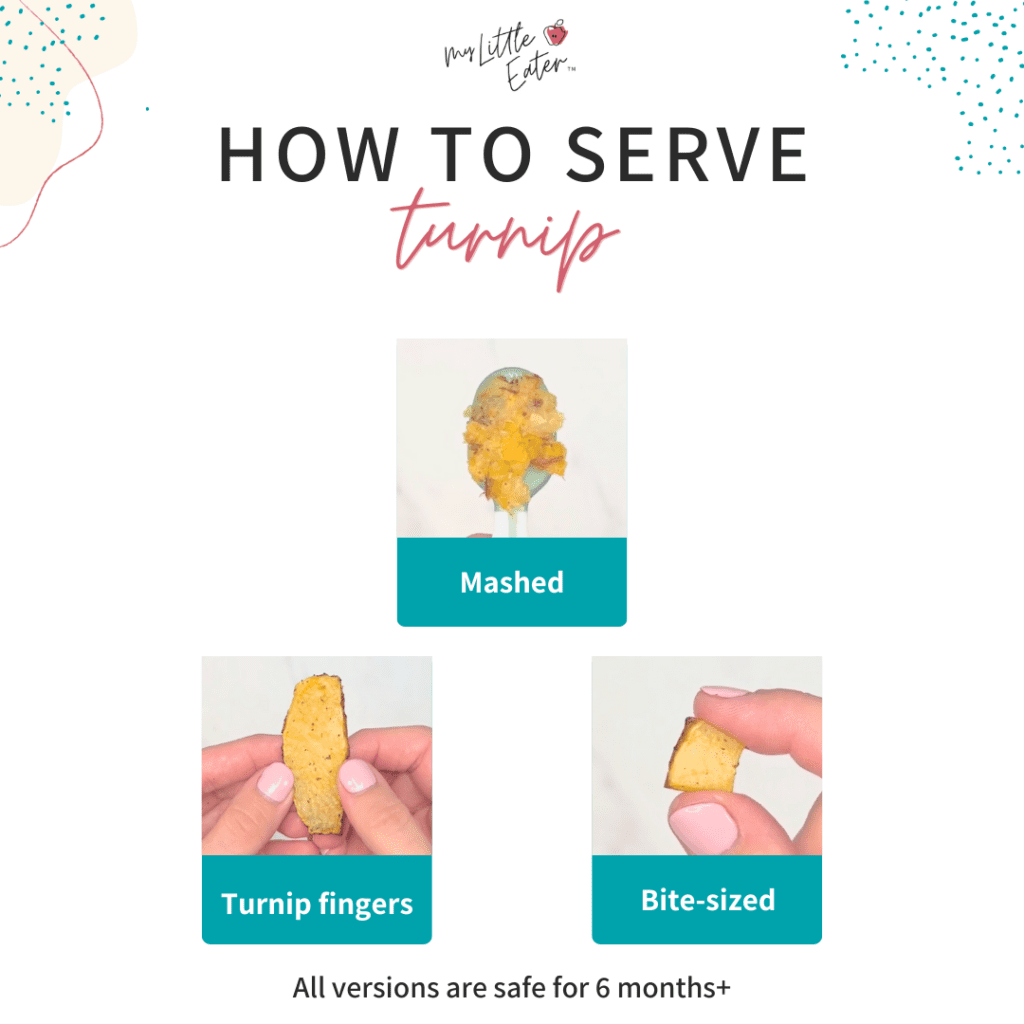
Mashed cooked turnip
- Preloaded spoon: Cook turnip by boiling it until it’s soft and can be easily mashed (about 35 to 45 minutes depending on the size). Mash with a fork and serve to baby on a preloaded spoon for them to self-feed with, spoon-feed it to them, or let them get messy by self-feeding with their hands.
Roasted turnip fingers or bite-sized pieces
- Palmar grasp: Serve roasted turnip in long finger shapes (about the length of an adult finger) for baby to eat using their palmar grasp.
- Pincer grasp: Once baby has developed their pincer grasp, you can cut the cooked turnip into small bite-sized pieces (½ to 1 inch in size).
BEST FOOD & SPICE PAIRINGS
- Foods: Potatoes, turkey, onion, or parsnips.
- Herbs and spices: Sage, cumin, thyme, or coriander.
Zucchini
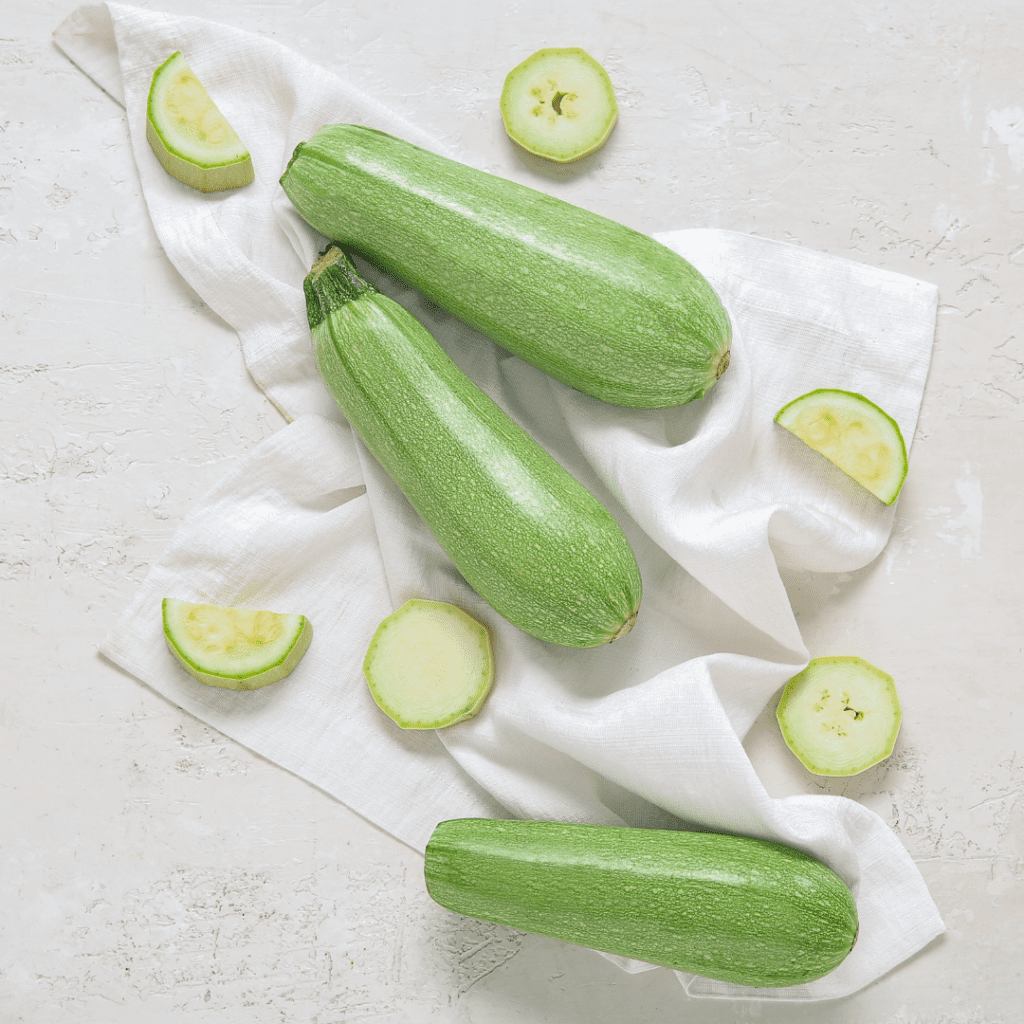
Zucchini comes in dark, light green, or white-spotted varieties, all of which have their own unique flavor and texture. Green zucchini are closely related to yellow squash (or “summer squash”) which has a bright golden, yellow, or deep-orange color (8).
NUTRITIONAL BENEFITS
Zucchini is rich in the following nutrients (13):
- Vitamin A: Zucchini is rich in beta-carotene, a term used to describe a type of plant compound. Our body converts some of these carotenoids into vitamin A, which is beneficial for forming and maintaining healthy teeth, tissues, mucus membranes, and skin, plus it promotes good eyesight.
- Dietary fiber: Zucchini is an excellent source of fiber, which is beneficial for gut health and digestion. It can help prevent constipation when consumed on a more regular basis.
- Potassium: This is beneficial for proper muscle function and regulation of blood pressure.
Zucchini provides other vitamins and minerals to support your little one’s growth and development including magnesium, manganese, and vitamin C (13).
HOW TO SERVE ZUCCHINI SAFELY
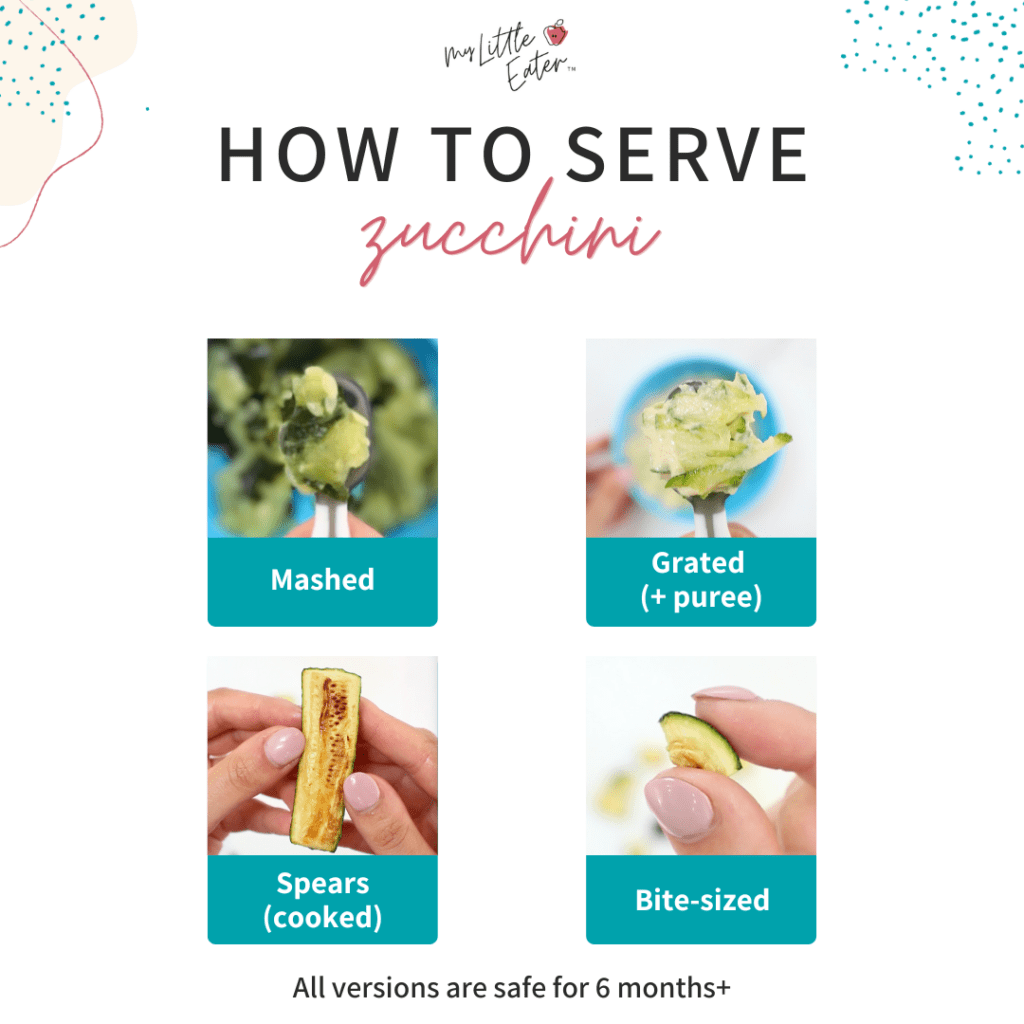
Mashed cooked zucchini
- Preloaded spoon: Cook zucchini by roasting it in the oven until it’s soft and can be easily mashed (400°F for 15 minutes). Mash with a fork and serve to baby on a preloaded spoon for them to self-feed with, spoon-feed it to them, or let them get messy by self-feeding with their hands.
Grated zucchini
- Preloaded spoon: Mix thinly grated, raw zucchini (made using a cheese grater) into a puree to bind the pieces together and add more moisture. You can use Greek yogurt, hummus, or mashed potato. Serve to baby on a preloaded spoon for baby to self-feed with.
Roasted spears or bite-sized pieces
- Palmar grasp: Serve roasted zucchini in long spears (about the length of an adult finger) for baby to eat using their palmar grasp.
- Pincer grasp: Once baby has developed their pincer grasp, you can cut cooked zucchini into small bite-sized pieces (½ to 1 inch in size).
BEST FOOD & SPICE PAIRINGS
- Foods: Lentils, mushrooms, pork, or fish.
- Herbs and spices: Basil, garlic, or coriander.
Don’t forget about iron & healthy fats!
Now that you’re well-versed in how to serve a variety of fall produce to baby, let’s not forget to balance that out with a source of iron and healthy fat! Babies have very specific nutritional requirements, so it’s important that the meals we serve them are well-balanced to ensure they’re meeting those nutritional needs.
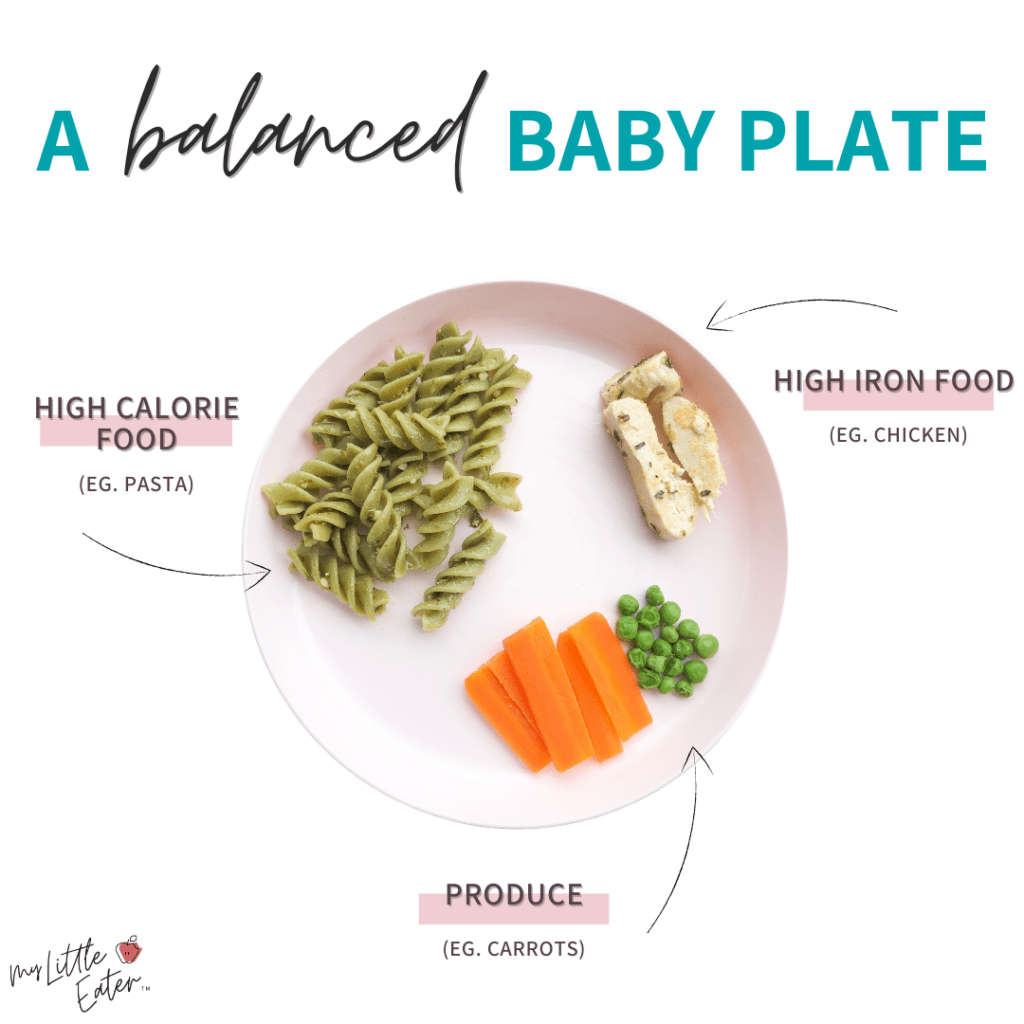
At around the 6-month mark, your baby’s iron reserves start to deplete, so it becomes important to provide them with iron-rich foods daily to support growth and development. High-iron foods include heme-iron foods from an animal source like meat, poultry, and seafood or a plant-based source of non-heme iron like beans, eggs, and tofu.
Considering a baby’s brain actually doubles in size in the first year, it’s crucial to offer high-calorie foods including those rich in healthy fats like omega 3’s and DHA to support healthy brain growth. To explore a full list of foods that are loaded with healthy fats for babies, you can check out our blog, here.
If you want to take all of the guesswork out of what to pair with fall produce, be sure to check out our 60 Day Baby Led Feeding Meal Plan! You’ll get access to over 80 recipes and can follow along with the plan to strategically introduce allergens, advance your baby in textures, and ensure all nutrient needs are being met. The plan is also perfect for the whole family – the recipes are delicious and designed to be able to serve them to everyone in the household – picky toddlers included!

Family Friendly Recipe: Pumpkin Pancakes
These pumpkin pancakes are perfect for babies, toddlers, and parents! Not only are these fluffy pancakes absolutely delicious, but they also make a great baby led weaning first food, and are highly nutritious! You can serve pumpkin pancakes for breakfast or dinner, and freeze any leftovers for busy mornings or an easy daycare lunch!
We recommend making a double batch (or even triple!) so that you can make baby pancakes, plus Mom and Dad-sized pancakes! You can also make a large batch of baby pancakes and freeze them for later – super convenient for an easy breakfast on a busy morning.
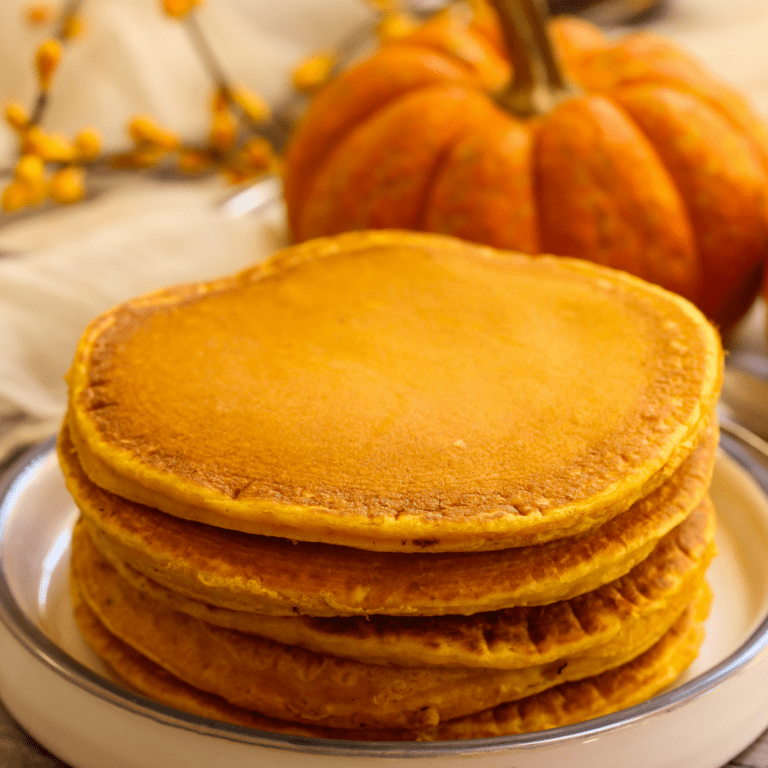
Pumpkin Pancakes
Equipment
- skillet
Ingredients
- 2 eggs
- ¾ cup pumpkin puree
- ⅔ cup unsweetened vanilla oat milk
- 2 tsp vanilla extract
- 1 ½ cups oats
- 2 tsp baking powder
- 1 tsp ground cinnamon
- ½ tsp allspice
- ½ tsp nutmeg
- ½ tsp ground ginger
- Coconut oil for cooking
Instructions
- Preheat non-stick skillet on medium heat. Melt small amount of coconut oil in the pan.
- Combine all ingredients (excluding the coconut oil) in a blender and blend until mixed.
- Pour 2-3 tablespoons of batter on the skillet for each pancake, and cook for 2-3 minutes on each side, or until the batter bubbles through. Let cool slightly. Cut into 3-4 inch long strips (about 1 inch wide).
- Plate pancake fingers. Enjoy!
Notes
Love it? Pin it to save for later!
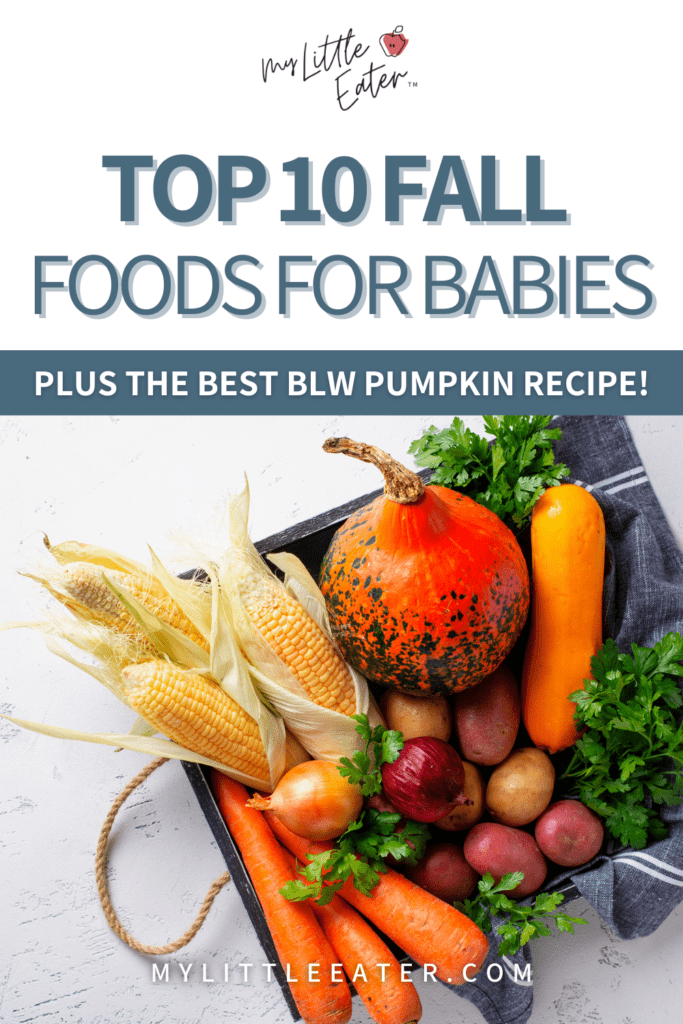
References:
- Macdiarmid, J. I. Seasonality and dietary requirements: will eating seasonal food contribute to health and environmental sustainability?. Proceedings of the Nutrition Society, 73(3), 368-37, 2014.
- Oyenihi, A. B., Belay, Z. A., Mditshwa, A., & Caleb, O. J. “An apple a day keeps the doctor away”: The potentials of apple bioactive constituents for chronic disease prevention. Journal of Food Science, 87(6), 2291-2309, 2022.
- Dhiman, A. K., Sharma, K. D., & Attri, S. Functional constituents and processing of pumpkin: A review. Journal of Food Science and Technology, 46(5), 411, 2009.
- Chen, L., Zhu, Y., Hu, Z., Wu, S., & Jin, C. Beetroot as a functional food with huge health benefits: Antioxidant, antitumor, physical function, and chronic metabolomics activity. Food Science & Nutrition, 9(11), 6406-6420, 2021.
- Awulachew, M. T. (2022). A Review to Nutritional and Health Aspect of Sprouted Food. Int. J. Food Sci. Nutr. Diet, 10(7), 564-568, 2022.
- Niño-Medina, G. U. I. L. L. E. R. M. O., Urías-Orona, V. A. N. I. A., Muy-Rangel, M. D., & Heredia, J. B. Structure and content of phenolics in eggplant (Solanum melongena)-a review. South African Journal of Botany, 111, 161-169, 2017.
- Nikolić, N. Č., Lazić, M. M., Karabegović, I. T., Stojanović, G. S., & Todorović, Z. B. A characterization of content, composition and scavenging capacity of phenolic compounds in parsnip roots of various weight. Natural product communications, 9(6), 2014.
- Levy, J. Zucchini nutrition – low in calories & loaded with anti-inflammatory properties, 2023. Retrieved from https://draxe.com/nutrition/zucchini-nutrition/
- Dari, L., & Yaro, N. S. Nutritional composition and storage of Butternut squash, 2016.
- Healthy Babies Bright Futures. What’s in my baby’s food? 2019. https://www.healthybabyfood.org/sites/healthybabyfoods.org/files/2020-04/BabyFoodReport_ENGLISH_R6.pdf
- Alam, M. K. A comprehensive review of sweet potato (Ipomoea batatas [L.] Lam): Revisiting the associated health benefits. Trends in Food Science & Technology, 115, 512-529, 2021.
- Javed, A., Ahmad, A., Nouman, M., Hameed, A., Tahir, A., & Shabbir, U. Turnip (Brassica Rapus L.): a natural health tonic. Brazilian Journal of Food Technology, 22, 2019.
- Ben-Nun, L. Characteristics of Zucchini. Ben-nun, L., Ed, 2019.

ABOUT THE AUTHOR
CHELSEY LANDRY, RD
Community Dietitian at My Little Eater Inc., and bunny-mom to Hickory. Chelsey offers one-on-one counselling to parents of babies and toddlers that need more customized support. Learn more by booking a free discovery call with her today!

ABOUT THE AUTHOR
CHELSEY LANDRY, RD
Community Dietitian at My Little Eater Inc., and bunny-mom to Hickory. Chelsey offers one-on-one counselling to parents of babies and toddlers that need more customized support. Learn more by booking a free discovery call with her today!


